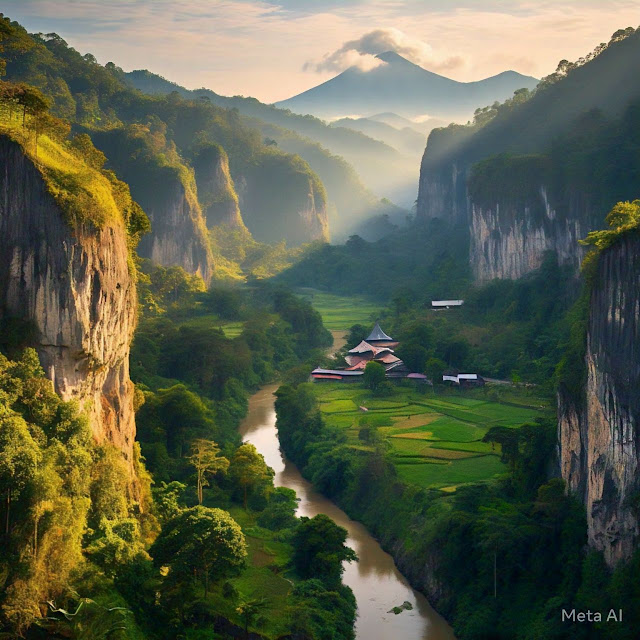Nestled in the lush landscapes of West Sumatra, Lembah Harau (Harau Valley) is a breathtaking destination that captivates visitors with its dramatic cliffs, vibrant greenery, and serene atmosphere. Located near Payakumbuh, this stunning valley is a must-visit for nature enthusiasts, photographers, and adventurers alike.
Dubbed the “Grand Canyon of Indonesia,” Lembah Harau offers not only unparalleled natural beauty but also a wide range of activities, from hiking and rock climbing to exploring cultural sites and waterfalls. Let’s delve into what makes this hidden gem a destination worth visiting.
Location and Accessibility
Lembah Harau is situated approximately 15 kilometers from the city of Payakumbuh and about 47 kilometers from Bukittinggi, making it a convenient stop for travelers exploring West Sumatra. The valley lies in the 50 Kota Regency, surrounded by the Bukit Barisan mountain range.
Visitors can reach Lembah Harau by car or motorbike, with well-paved roads leading to the site. The journey itself is a scenic drive through traditional Minangkabau villages, rice fields, and rolling hills, offering glimpses of the region’s natural and cultural charm.
The Enchanting Landscape
The most striking feature of Lembah Harau is its towering granite cliffs, which rise to heights of 150 to 300 meters. These majestic rock formations encircle the valley, creating a dramatic and awe-inspiring backdrop. The cliffs, which glow golden under sunlight, are adorned with patches of green moss and cascading vines, adding to their visual appeal.
The valley floor is equally captivating, with verdant rice paddies, flowing streams, and small waterfalls dotting the landscape. This harmonious blend of rugged cliffs and lush greenery makes Lembah Harau a paradise for photographers and nature lovers.
Attractions and Activities
Lembah Harau is more than just a picturesque destination—it’s a playground for adventure, relaxation, and cultural exploration. Here are some of the highlights:
1. Waterfalls (Air Terjun)
The valley is home to several stunning waterfalls, each with its own unique charm. Among the most popular are:
- Air Terjun Sarasah Bunta: A multi-tiered waterfall that flows into a tranquil pool, perfect for dipping your feet or enjoying a picnic.
- Air Terjun Sarasah Donat: Named for the donut-shaped rock formation nearby, this waterfall offers a quieter spot for relaxation.
- Air Terjun Sarasah Aka Barayun: A must-see for its picturesque setting and accessibility.
These waterfalls are surrounded by lush vegetation, making them serene spots to connect with nature.
2. Rock Climbing
For adrenaline junkies, Lembah Harau is a world-class destination for rock climbing. The granite cliffs offer routes for climbers of all skill levels, from beginners to seasoned professionals. Several local operators provide guided climbs, ensuring a safe and thrilling experience.
3. Trekking and Nature Walks
The valley’s trails wind through rice fields, small villages, and forests, making it an ideal destination for trekking and nature walks. Along the way, visitors can enjoy stunning views, encounter local wildlife, and interact with friendly villagers.
4. Traditional Minangkabau Villages
Exploring the villages around Lembah Harau offers a glimpse into the rich culture of the Minangkabau people, known for their matrilineal traditions and iconic rumah gadang (traditional houses with curved roofs resembling buffalo horns). Visitors can observe daily life, sample local cuisine, and even stay in a traditional homestay for an immersive experience.
5. Photography Hotspots
From the towering cliffs to the serene rice paddies and sparkling waterfalls, Lembah Harau is a photographer’s dream. Sunrise and sunset are particularly magical times to capture the valley’s beauty, as the changing light accentuates the golden hues of the cliffs and the lush green landscape.
Tips for Visiting Lembah Harau
To make the most of your visit, keep these tips in mind:
- Best Time to Visit: The dry season (April to October) is the best time to visit, as the weather is ideal for outdoor activities and the waterfalls are still flowing.
- Bring Comfortable Gear: Wear sturdy shoes for trekking and climbing, and bring a raincoat in case of sudden showers.
- Pack Essentials: Sunscreen, insect repellent, and a reusable water bottle are must-haves for a day in the valley.
- Stay Overnight: Consider staying at a homestay or eco-lodge in the area to fully immerse yourself in the natural beauty and local culture.
- Respect the Environment: Keep the valley pristine by disposing of trash properly and avoiding damage to the natural surroundings.
Nearby Attractions
If you have time, explore these nearby destinations:
- Janjang Saribu (The Thousand Stairs): A unique stairway leading to incredible views of the surrounding hills.
- Payakumbuh City: Known for its vibrant markets and delicious Minangkabau cuisine.
- Bukittinggi: A historic town offering attractions like the Jam Gadang clock tower and Sianok Canyon.
Why Visit Lembah Harau?
Lembah Harau is more than just a sightseeing destination—it’s a sanctuary where nature, adventure, and culture converge. Whether you’re scaling cliffs, marveling at waterfalls, or simply soaking in the tranquility of the rice fields, the valley offers an experience that stays with you long after you leave.
Its accessibility from major towns like Payakumbuh and Bukittinggi makes it a convenient addition to any West Sumatra itinerary. For those seeking a break from urban life, Lembah Harau is the perfect escape into the heart of Indonesia’s natural and cultural heritage.
So pack your bags, grab your camera, and get ready to explore the enchanting beauty of Panorama Lembah Harau—a place where every corner is a postcard waiting to happen.


Komentar
Posting Komentar